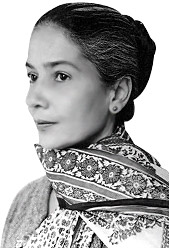Cry, the peacock is a story of a female whose own world collides with her husband`s practical world thus making her feel dejected, lonely and demoralized. The psychoanalytic growth of the character and the catastrophe where the character relates her own sufferings with that of the peacock and the part where she finally throws her husband from the parapet akin to the peacock that kills their mate after mating aptly justifies the title.
 The contemporary India is aptly illustrated in Anita Desai`s write-ups. The patriarchal culture, the personal conflict of identity of the anglicized women of the Indian society gains a dimension in the hands of Anita Desai, the storyteller of the contemporary India. Born on June 24th in the year of 1937, Anita Desai competently illustrates the unaltered real nesses of the Indian society in the subtlest way. Ambitious sentence construction teamed with the unconventional syntax that is her so very original marks Anita Desai as the novelist of the era where reality so very well harmonizes with fantasy. Psychological developments of character is the basic crux which dominates almost all the works of Desai while making her characters to stand apart. With her remarkable style, Anita Desai is seen in some of her novel often patronizing the effectiveness of escapism, again seldom turning around to face the questions with an upright shoulder. Essentially romantic, truly pulsating and effectively realistic, Anita Desai, is definitely one of the Indian writers who with their pen tried to alter the clichéd dogmas of the contemporary Indian society.
The contemporary India is aptly illustrated in Anita Desai`s write-ups. The patriarchal culture, the personal conflict of identity of the anglicized women of the Indian society gains a dimension in the hands of Anita Desai, the storyteller of the contemporary India. Born on June 24th in the year of 1937, Anita Desai competently illustrates the unaltered real nesses of the Indian society in the subtlest way. Ambitious sentence construction teamed with the unconventional syntax that is her so very original marks Anita Desai as the novelist of the era where reality so very well harmonizes with fantasy. Psychological developments of character is the basic crux which dominates almost all the works of Desai while making her characters to stand apart. With her remarkable style, Anita Desai is seen in some of her novel often patronizing the effectiveness of escapism, again seldom turning around to face the questions with an upright shoulder. Essentially romantic, truly pulsating and effectively realistic, Anita Desai, is definitely one of the Indian writers who with their pen tried to alter the clichéd dogmas of the contemporary Indian society.
Synopsis:
Winner of the Sahitya Academy Award, Cry, the peacock is Anita Desai`s first work. Diffused in varied elements of psychology and indeed psychiastry Anita Desai`s Cry, the peacock has been considered as "the first step in the direction of psychological fiction in Indian writing in English". The story ideally deals with the psychological consciousness of the female protagonist and is aptly illustrated amidst detail images, monologues and flashbacks. The female character "Maya " in Cry, the peacock envelops the reader as she unfolds the growth, development and climax of her neurosis. Maya is a young girl obsessed by a childhood prediction of disaster. The story unfolds that Maya`s father without thinking much married her off to his own lawyer friend - Gautam who was middle aged man. The marriage was never fruitful and slowly Maya turns into a psychopath whose emotional needs were seen to be collided with that of the extremely practical outlook of her husband. The climax of the story lies when Maya`s attachment with her father further develops into an "Electra complex" which again acts as the catalyst in the deflowering of her marital relationship with her husband. Extremely frustrated, Maya then looks back to the days of her childhood spent with her father. This reminiscence of those long lost days serves as the defense mechanism to set her free from her inner frustration and conflicts.
This dark state of affair is again totally unacceptable by the conscious mind of Maya. She therefore relaxes her tension, eases her frustration by pondering unconsciously on how " peacocks breaks their bodies" in order to relieve their own pain. Here comes the sense of violence, the feeling of killing or get killed which engulfs Maya. The violent desire of killing her husband awakening from her own frustration as revenge against his icy cold impassiveness and indifferences weaves the story of Cry, The Peacock.
Published by the Vision Books Pvt. Ltd., India and by the Architectural Book Publishing Company, Cry, The Peacock is one of the best works of Anita Desai.
The very concept that women need something more than just food, clothes and accommodation is aptly illustrated in this novel. The hyper sensitive mind of the women is illustrated by Desai in the most tender way where the atmosphere of tension is set ideally against the backdrop of a sultry Indian summer. The nonviolence story, in the Cry, the Peacock, Anita Desai finally leaves it on to the readers to complete the story. The oppression and depression, the anxiety and fear, the frustration and foiling of the female protagonist set against a typical Indian scenario brings out the very best of the writer in a coherent way.













